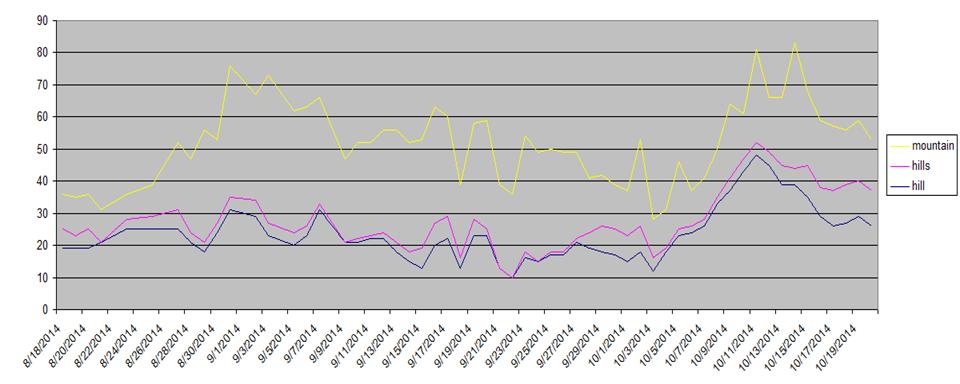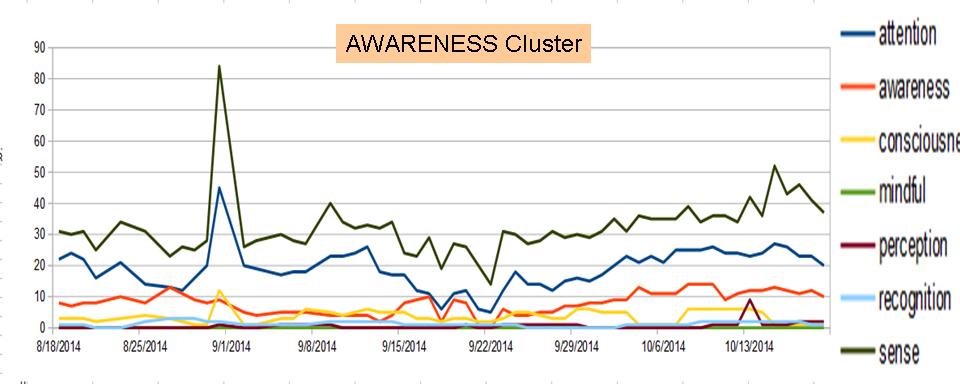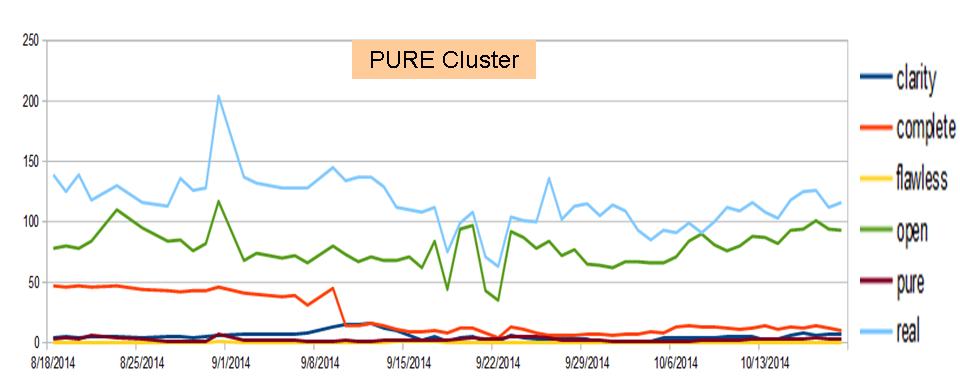Note: Perhaps just coincidence, but within about 25 minutes of publishing this article, the entire website went down for about 3 hours. A few people managed to gain access, but all admin/elders/mods were left out in the dark. Hmmmm….
Henry Adams said, “Chaos was the law of nature; Order was the dream of man.”
In other words, there is only chaos.
Are dreams chaotic? Seriously…are dreams just total nonsense, made up of totally random symbols and absurd metaphors? Surely you’ve had at least a few dreams that match that description. If we were to ask Henry Adams, I’m guessing he’d agree that dreams are TOTALLY chaotic and random.
Now imagine the collective set of dreams. If you were to take a sample of words, even if nearly identical in nature and measure their occurrence daily in the collective dreamscape. Would we see identical lines on the graph, or would the occurrences be completely random?
Take for example, pregnant and baby. We’ve already demonstrated that these two words do tend to be used together in sentences, and therefore, it’s natural to see their graphs looking very similar. But what about other words that aren’t typically used together?
Personally, I assumed that as long as two words aren’t used together in sentences, then we’d only see complete randomness in their patterns. Of course, I thought there might be some coincidental trends at certain periods, but all in all, the graphs would look completely different. Boy was I wrong. It turns out that even though the DreamBot (all versions) looks for “hill” and “hills” separately as two completely different words, their raw hits rise and climb as if they are actually the same word! (see graph below) I thought that was pretty profound (see blue and purple lines in the chart).
Of course, some people may not marvel over the resemblance here, so I decided to add another similar word….mountain (similar only in meaning). When looking at the graph again (yellow line), it’s not hard to recognize the same general trends; however, there are some definite diversity, particularly with interim peaks and valleys. To be honest, the more you know about collective dream trends, I think the MORE surprised you’d be to see these graphs.
Maybe this info so far isn’t so surprising to some people. So let’s take some other word pairings. This time, we take words that sort of mean the same thing, but which would not be typically used in the same sentence, paragraph, or especially the same dream.
Just to add to the complexity here, keep in mind that both of the following graphs were assembled this past weekend as I was getting prepared for statistical analysis on our exciting P2 mission.
The reason I specify this is because I didn’t go searching for words to demonstrate a certain graph. The words were chosen because of congruence in meaning, and then I just happened to put them into a graph. The results are in my opinion spectacular. In our first graph below, there are only two lines out of the 7 that really look near identical: “Sense” and “Attention.” The red line (Awareness) does have some of the same characteristics, but is definitely not quite as tight.
If that wasn’t enough, we needed another cluster, and so I created another graph. Same results as the last…2 of the lines (“Real” and “Open”) look strikingly similar, but all the others seem unaffected / incongruent.
…and now, consider putting these graphs together, and isn’t this peculiar…All the top lines overlap perfectly as if these two clusters were the same word.
Now consider these graphs as various stock market indices. You can look at all three of the graphs and see how there might be macro-level economic events that make all the lines go up and down. The general big trends are definitely there. We have generalized peaks and troughs across the bigger landscape, but remember that not all clusters are following some of the bigger macro trends. Remember Dallas? Remember the Apocalypse cluster? For some reason the words we chose for this latest P2 run are correlated very tightly for some reason.
The collective unconscious appears to ebb and flow with bigger forces, but then again, there are smaller trends at play. For example, we see similarities in the overall comparison of “Mountain” (1st graph—yellow), and “Real” (3rd graph—blue), but there are definitely some smaller peaks and troughs that are unique to just that cluster, which in the economic world might equate to industries.
Thus, we have established here that Carl Jung’s theory does seem to hold true: “In all chaos there is a cosmos, in all disorder a secret order” (Carl Jung, “Archetypes of the Collective Unconscious”). If there was previously one word to describe the nature of dreams, is there anyone who would have argued against using the word “CHAOS?” This article is just the beginning, though, because one of our DreamBots will be dedicated for sniffing out these correlations.
Summary and Implications
Folks, our new graphing platform, although time consuming and very manually intensive at this point, is showing us that there is a DEFINITE ORDER in the collective psyche that on the surface looks completely random and chaotic. Who would have ever thought that the actual words we use in our dream write-ups could be ordered and predictable? For example, we established that if we see a 10% increase in the word “Hill” that we will also see a similar rise in the word “Hills” and a good probability of a similar rise in “Mountain.”
For number-hungry people and dream-analysts alike, this could be a quantum breakthrough in creating all sorts of new hypotheses and meaningful theories about the collective dreamscape. Buckle in readers…we’re just now tapping in. Carl Jung’s “Secret Order” is just now being revealed!!
---------- NDC Announcments -----------
Don’t miss our daily DreamBot run which shows a brief status of the collective unconscious.
Copyright © 2014 Chris McCleary. Except for quotes, all rights reserved and any reference about this material requires a link back to this page.





You been workin’ hard – pretty exciting stuff~!
Can’t get something from nothingness, so order has always been *wink…
Chaos defined of old as a “gaping void” – a void is something, a place (holder) if you will, like a cell or a honeycomb. What good is a bucket without the inside… The main part of the structure is the void aka chaos.
A valley is a hill turned upside down and, without the void, they disappear~! :”)
chaos –
ORIGIN late 15th cent. (denoting a gaping void or chasm, later formless primordial matter): via French and Latin from Greek khaos ‘vast chasm, void.’
http://dictionary.reference.com/browse/chaos
Several weeks ago, (for various reasons), I decided that if I were to say one thing about dreams, it would be, “Dreams are mysterious.” Just because we don’t understand them doesn’t mean they are not understandable.
Not all of my dreams are chaotic by any means. Mostly the ones about clutter.
Can Chaos be artificially replicated? And is it prudent to do so? (Chuckle)
I know that synchronicity can be artificially created. I have done it before.. i even have a paper “somewhere” I describe it and how it can be achieved. And it worked well. Developing a meme and its archtypes .
I know that even random chip generators have pre determined algorithms. I worked in casino’s for some time and all slot machines to the player seem random, but they are run on templates. Which are predetermined percentages. Although at the floor level, player level it is for the most part random selection or “luck of the draw” so to speak.
Good insite Chris. Thank you for this post. I will have a thought on this.